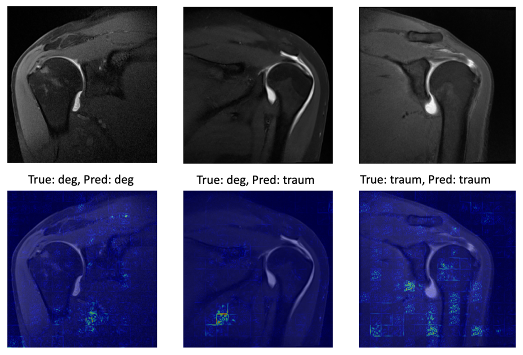German Congress of Orthopaedics and Traumatology (DKOU 2025)
Deutscher Kongress für Orthopädie und Unfallchirurgie 2025 (DKOU 2025)
Development of a vision transformer model for predicting traumatic versus degenerative rotator cuff tears on MRI: A single-center retrospective study
2Hospital for Special Surgery, New York City, USA
3Research in Orthopedic Computer Science, Balgrist University Hospital, University of Zurich, Zürich, Schweiz
Text
Objectives and questions: The differentiation between traumatic and degenerative rotator cuff tears (RCT) remains a diagnostic challenge with significant implications for treatment planning. While magnetic resonance imaging (MRI) is standard practice, traditional radiological interpretation has shown limited reliability in distinguishing these etiologies. This study evaluates the potential of Artificial Intelligence (AI) models, specifically a Vision Transformer (ViT) (Figure 1 [Fig. 1]), to differentiate between traumatic and degenerative shoulder pathologies on MRI.
Material and methods: In this retrospective, single-center study, we analyzed 99 clinically validated shoulder MRI datasets from patients who underwent surgery at a specialized university shoulder unit between 2016 and 2019. The cohort was divided into training (n=79) and validation (n=20) sets. Inclusion criteria for the traumatic group required a documented relevant trauma (excluding simple lifting injuries), previously asymptomatic shoulder, and MRI within 3 months post-trauma. The degenerative group was matched for age and affected tendon, with patients presenting with at least one year of constant shoulder pain prior to imaging and no trauma history. Exclusion criteria included age >66 years, Goutallier Grade >II muscle atrophy in the affected muscle, and previous shoulder surgery. The ViT model was trained using the Adam optimizer with a learning rate of 1×10−5 over 60 epochs, employing 5-fold cross-validation. Saliency maps are utilized as an explainability tool. All research was conducted according to the TRIPOD guidelines.
Results: The ViT model achieved an accuracy of 0.72 ± 0.03 with a recall of 0.71 ± 0.09, specificity of 0.72 ± 0.06 and a F1 score of 0.7 ± 0.07. Analysis of the confusion matrix revealed that the model correctly identified an average of 7.2 ± 2.5 traumatic and 7.2 ± 2.48 degenerative cases per validation set. The model maintained consistent performance across different patient subsets, demonstrating robust generalization. Saliency maps do not show a consistent focus on the rotator cuff (Figure 2 [Fig. 2]).
Discussion and conclusions: AI shows potential in supporting the challenging differentiation between traumatic and degenerative rotator cuff tears on MRI. The achieved accuracy of 72% is particularly significant given our stringent inclusion criteria and age-matched cohorts, which presented a challenging diagnostic scenario. Saliency maps were utilized to ensure explainability, the given lack of consistent focus on rotator cuff tendons hints towards underappreciated aspects in the differentiation. These findings establish a foundation for developing AI-assisted diagnostic tools in musculoskeletal radiology, potentially enhancing both diagnostic accuracy.






